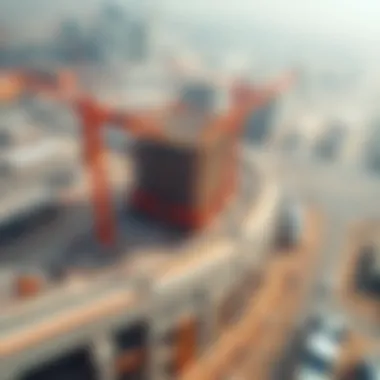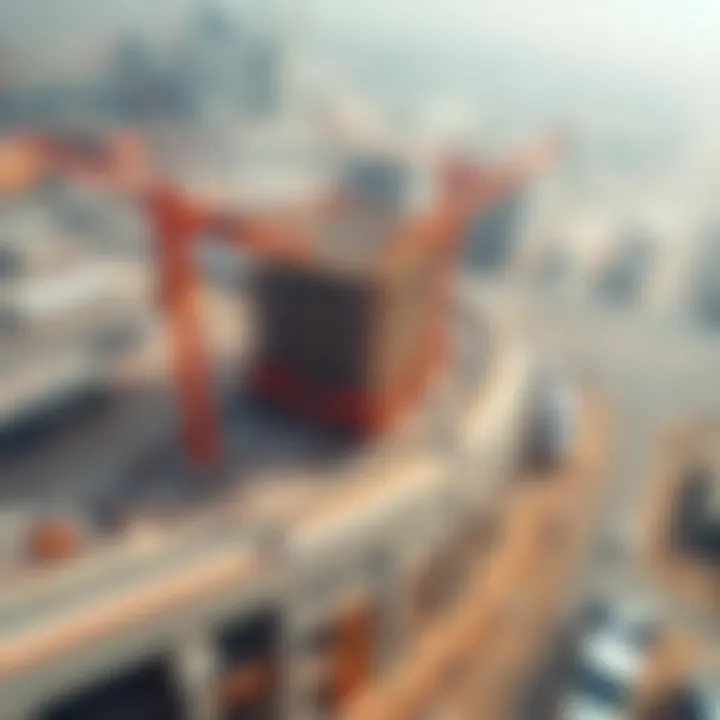Etihad Rail and Its Impact on Dubai's Real Estate


Intro
As the Etihad Rail project rolls out, the wheels are in motion, not just for trains but for the very fabric of Dubai's real estate market. This ambitious initiative promises to connect regions across the UAE, enhancing accessibility in a country where the desert meets the skyscrapers of modern living. So, what does this mean for investors, homebuyers, and real estate agents navigating the landscape?
In this article, we will dive into the implications of Etihad Rail on Dubai’s real estate sector. We’ll explore the infrastructure advancements, economic ripple effects, and the future landscape as shaped by this transportation revolution. Understanding these dynamics offers crucial insights for anyone looking to invest or engage in the ever-evolving property market in one of the world's most vibrant cities.
Market Overview
The roll-out of the Etihad Rail project is expected to impact the real estate market in various significant ways. Let’s take a closer look at the current trends, forecasts, and predictions regarding how this infrastructure project is reshaping the market.
Current Trends
In recent times, there's been a noticeable uptick in property development along planned railway corridors. Developers are keenly aware of the increasing desirability of areas with convenient rail access. These areas are often poised for a surge in property values as they draw not only residents but businesses looking for more accessible locations.
With the rising emphasis on sustainability and innovation, green developments are also catching the eye. Properties that emphasize energy efficiency, smart technologies, and community living are more appealing than ever. Areas around the new railway stations are beginning to reflect these values, making them hot spots for investors.
Forecast and Predictions
Looking ahead, the interconnectedness promised by the Etihad Rail project is anticipated to bring about substantial changes. Early predictions suggest that integrated transport solutions can boost property demand across the board, particularly in the suburbs and less-developed areas that haven’t seen much investment until now.
Investments in infrastructure typically lead to long-term appreciation and yield potential. Market analysts forecast a potential increase in property prices ranging from 15% to 25% in certain sectors within the next five years, particularly in areas surrounding new station developments.
“The introduction of Etihad Rail is not just about rail connectivity; it’s a catalyst for economic growth and real estate transformation in Dubai.”
Investment Opportunities
With the Etihad Rail project paving new tracks for development, significant investment opportunities are emerging on both residential and commercial fronts.
Residential Properties
The impact of improved connectivity cannot be understated when it comes to residential investments. Areas previously considered distant or less attractive are now becoming appealing to homebuyers and renters who prioritize accessibility. This shift is particularly prominent among younger demographics who are looking for balance; being close enough to work without the burden of congested urban life.
Property developers are responding by focusing on integrated communities that offer amenities and transport solutions, helping buyers visualize their lifestyle potential and enhancing property values. For instance, developments near key connections like the Dubai Marina and Downtown are receiving prime spots on every investor's radar.
Commercial Ventures
The commercial side of things is buzzing along the new railway routes. The ease of access brought about by the railway is expected to attract businesses looking to cater to a wider customer base. Areas that gain stations will likely see a rise in retail spaces, office developments, and mixed-use projects plus a surge in foot traffic that benefits all commercial stakeholders.
In short, the Etihad Rail not only stands as a transport initiative but is also shaping a vibrant commercial ecosystem as it continues to evolve. This dual access creates fertile ground for substantial returns on commercial investments.
Overall, Etihad Rail is more than a simple line connecting points on a map; it’s a transformative force that will undoubtedly shape the future landscape of Dubai’s real estate market. With every mile laid down, opportunities multiply for investors, homebuyers, and that’s not something to throw a light switch on; it’s time to bring out the binoculars and look ahead!
Intro to Etihad Rail
Understanding Etihad Rail is more than just getting acquainted with another infrastructure project. This initiative represents a pivotal shift in the transportation and economic landscape of the United Arab Emirates, particularly influencing Dubai's bustling real estate market. With the ambitions of creating a seamless rail network that interlinks major cities, this project is not merely about trains running on tracks; it's about the fabric of connectivity woven into the urban planning and economic growth of the areas it touches.
Overview of the Project
Etihad Rail seeks to be the backbone of the UAE's transport system. It envisions a comprehensive railway network stretching across the nation, facilitating not only passenger travel but also freight operations. This is particularly significant as it aims to reshape the logistics scene in Dubai and beyond. The distinct phases of the project will introduce a modern, efficient means of moving people and goods, addressing traffic congestion and reducing travel times. The rails are designed to support both long-distance commuter routes and commercial freight transport, making it essential for a growing economy.
The first phase of the project focuses on a route that will connect the cities of Abu Dhabi and Dubai, notably shrinking the time required to travel between these two crucial urban centers. A system like this could potentially shift the perception of distance, bringing business hubs closer together and fostering a more integrated regional economy. What’s more significant is how this integration will eventually catalyze urban and suburban development, laying the groundwork for new residential neighborhoods and commercial centers along the route.
Objectives and Goals
The goals set by the Etihad Rail project are ambitious and multi-faceted. They go beyond the immediate functional benefits of a rail network. Here’s a look at some of the key objectives:
- Enhancing Connectivity: One of the primary aims is to improve the connectivity between cities, enabling both residents and businesses to thrive with easier access.
- Promoting Sustainable Transportation: By providing an alternative to road travel, the project aims to support environmental initiatives, including lowering carbon emissions and reducing traffic on highways.
- Stimulating Economic Growth: The developers of the project also anticipate a significant boost in economic activity, particularly in real estate sectors, due to increased accessibility and improved infrastructure.
- Noise Reduction and Urban Revitalization: Modern railway designs help minimize noise pollution and improve vibrancy in urban areas, transforming old industrial sites into bustling commercial and residential districts.
In summary, Etihad Rail is not merely another transportation initiative; it’s a strategic enabler for economic and urban growth in Dubai. It serves as a framework for expansion and modernity, resonating with potential investors looking for burgeoning opportunities in a dense market ripe for transformation.
"The rails of Etihad are more than just steel and concrete; they are pathways to future growth, connecting dreams with opportunities."
For more information on such infrastructure projects, you may explore Etihad Rail. More details can also be found on platforms like Britannica or various regional publications discussing transport innovations in the UAE.
Historical Context
Understanding the historical context of the Etihad Rail project enriches one's perspective on its significance, both as a construction endeavor and as a catalyst for change in Dubai's real estate landscape. Tracing back to the early aspirations of the UAE to create a unified transport network, this project represents more than simply laying down tracks. It embodies a vision of connectivity and economic prosperity that has evolved over the years.
Timeline of Development
The journey of Etihad Rail began with the preliminary phases in 2009, when discussions and planning materials first went public. Fast forward to 2016, the UAE government made a steadfast commitment, channeling resources into what is now heralded as one of the largest railway initiatives in the Middle East. Here’s an overview of significant milestones:
- 2009: Initial planning discussions commence, aiming for seamless connectivity across the Emirates.
- 2016: Formal announcement of the Etihad Rail project, with a focus on enhancing trade and logistics.
- 2018: Construction begins, with ground-breaking on key segments of the line.
- 2022: Initial sections near completion, setting the stage for industrial and tourism opportunities.
These phases highlight a measured approach to developing not only infrastructure but also an integrated strategy that anticipates future demand. The timeline symbolizes strategic thinking that aligns with broader economic goals, indicating that the rail system will not go live in a vacuum.
Previous Transportation Initiatives
When evaluating the past frameworks of transportation within the UAE, several notable initiatives come to mind. These applications provide insight not just into what went well but also lessons learned that shaped the current undertaking:
- Dubai Metro: Launched in 2009, this was a significant urban advancement that enhanced accessibility throughout the metropolitan area. Importantly, the metro’s success laid groundwork for public transit acceptance among locals and investors alike.
- Abu Dhabi BRT: Designed to interlink Abu Dhabi’s key areas, the Bus Rapid Transit system has faced challenges, yet it demonstrates the desire to create a cohesive transport experience across the emirate.
- National Rail Development Plan: Before Etihad Rail, there were attempts to propose an integrated rail network to support trade and freight, though progress lagged.
The lessons from these past projects offer valuable blueprints. They highlight the importance of sustained public buy-in, attention to consumer needs, and the need for adaptive strategies to cater to logistical complexities. Whereas previous initiatives, like the Dubai Metro, were urban-centric, Etihad Rail aims to connect the greater geographical spread of the Emirates, thus broadening its impact on both commercial and residential property sectors.
Through this historical lens, the impact of Etihad Rail is magnified. It’s not just about new tracks; it’s about interweaving the fabric of transport and real estate development, much like laying the stones for a robust economic future. By situating this project within its historical lineage, stakeholders can clearly see the strides made and the potential magnitude of future returns on investments.
Technical Aspects of Etihad Rail
The technical aspects of Etihad Rail are not just about blueprints and numbers; they represent a vital cog in the wheel of Dubai's future connectivity and economic vibrancy. Understanding these elements is crucial for several stakeholders—be it investors eyeing valuable surface, homebuyers, or local real estate agents. The fundamental engineering and innovative technologies employed can set the foundation for sustainable development and urban growth, ensuring the railway not only transports goods and people but also stimulates the housing and commercial sectors that lie in its wake.


Engineering and Design
When discussing the engineering and design of Etihad Rail, one can't help but appreciate the architectural ambition behind this project. It isn't merely about laying down tracks; rather, it involves creating a cohesive network that can seamlessly link various emirates while accommodating the unique geographical challenges of the UAE.
The design process factors in several key elements:
- Topography Considerations: Given the UAE's desert landscape, engineers have had to devise solutions for minimizing disruption to the delicate ecosystem while optimizing for speed and safety.
- Station Architecture: The design of railway stations plays a pivotal role. They aren't just transit points but are crafted to enhance user experience. Features such as accessibility, aesthetics, and efficiency are essential.
- Durability and Safety Standards: The materials chosen for the tracks and stations must withstand not just the wear and tear of frequent use, but also harsh environmental conditions that can range from extreme heat to sandstorms.
By prioritizing these factors, the overall design fulfills a dual role—it serves the immediate needs of rail users while picturing a more extensive socio-economic landscape influenced by better transportation.
Technology and Innovations
In the realm of Etihad Rail, technology and innovation are at the forefront of revolutionizing how transportation will function in the UAE. The integration of modern tech solutions ensures efficiencies are achieved in ways older rail systems simply cannot match.
Some noteworthy innovations include:
- High-Efficiency Trains: The use of energy-efficient trains not only reduces the carbon footprint but also lowers operational costs. Adopting such technology serves dual purposes—environmental stewardship and financial prudence.
- Smart Tracking Systems: Implementing advanced tracking is another leap forward. These systems enhance schedule reliability and provide real-time updates to passengers, bolstering user satisfaction.
- Automated Maintenance Systems: Utilizing technology to predict maintenance needs reduces downtime. This is crucial for ensuring that the services remain consistent and dependable, thereby fostering consumer trust.
In summary, the engineering and technological aspects of Etihad Rail are interconnected, each influencing the other. The project’s success hinges on its ability to marry these advanced methodologies with practical outcomes, ultimately re-shaping the real estate contours of Dubai.
The future of rail travel in the UAE isn't just about transporting people; it's about creating an entire ecosystem of opportunities that arise from enhanced connectivity.
Economic Implications
The Etihad Rail project isn’t just about trains and tracks; it stands as a cornerstone for the economic future of Dubai and the UAE. The ripple effects of this ambitious initiative will extend far beyond mere transportation improvements, reshaping trade dynamics and fuelling economic growth in a multitude of ways. As local and international businesses explore the opportunities this infrastructure will bring, the implications become central to understanding not only the real estate market but also the broader economic landscape of the region.
Impact on Regional Trade
The launch of Etihad Rail is set to significantly enhance regional trade by facilitating seamless movement of goods across the Emirates. With the rail network linking key industrial zones and seaports, businesses will enjoy reduced logistics costs and transit times. This connection enables both local vendors and multinational corporations to optimize their supply chains.
- Efficiency Boost: Traditional trucking routes can often be bottlenecked by traffic, weather, or various other hurdles. Rail transport will alleviate some of these issues by providing a more reliable and predictable method for goods to be moved.
- Market Reach Expansion: Manufacturers and suppliers can now reach a broader market, making trade easier, faster, and potentially cheaper. This opens the door for smaller businesses to scale up operations and compete in a larger arena.
- Attracting Investment: Enhanced logistics capabilities often lead investors to take a closer look at a region's potential. The efficiency offered by Etihad Rail can position Dubai as a key logistics hub, attracting foreign investment in various sectors.
Overall, this railway project promises to serve as a backbone for the emerging economic landscape, fostering a more interconnected marketplace and heightening Dubai's appeal as a strategic trade center in the Middle East.
Job Creation and Economic Growth
With any large-scale infrastructure initiative like Etihad Rail, job creation is a dominant theme. The impacts are both immediate and long-lasting, as various phases of the project unfold.
- Direct Employment: The construction phase itself demands a skilled workforce. Engineers, project managers, and laborers will all find opportunities as the project progresses. According to estimates, thousands will be employed during the building phase alone.
- Indirect Job Creation: Beyond construction, the rail project will stimulate job growth in logistics, manufacturing, retail, and service industries. More trains mean more goods transported, which drives demand for warehousing, distribution, and customer support services.
- Skill Development: Programs designed to train workers in new technologies and operational strategies will emerge. This bolsters the local workforce, making it competitive in a rapidly evolving global market.
- Economic Multiplier Effect: Jobs created will have a cascading effect on the local economy. As employees earn wages, they spend in their communities, which in turn supports local businesses—from coffee shops to tech startups, fostering a vibrant economic ecosystem.
A thriving economy leads to increased consumer confidence and spending, which further propels real estate development and investment opportunities. Residents and investors alike can then reap the benefits of this growing environment.
"Infrastructure sets the stage, but it’s the people who build the dreams."
Influence on Real Estate Market
The influence of the Etihad Rail project on Dubai's real estate landscape cannot be overstated. This monumental undertaking is set to enhance not just connectivity within the Emirates but also reshape the landscape of property demand and valuation dramatically. As the rail network progresses, it fuels a buzz of anticipation among investors, agents, and potential homebuyers. It is particularly vital to understand the nuances of this influence as it encompasses shifts in property demand and alterations in property values that are intricately linked to the availability and accessibility of transportation options.
Shifts in Property Demand
As the Etihad Rail system gears up for operation, we can expect to see significant shifts in property demand across Dubai and surrounding areas. Real estate becomes more attractive in regions directly serviced by the train routes. This can lead to:
- Increased Interest in New Developments: Areas once considered remote may now draw attention from developers eager to meet the needs of future commuters.
- Easier Accessibility: Properties located near major rail stations are likely to see a spike in demand as commuters prioritize convenience over distance.
- Population Growth: The improved connectivity may lead to an influx of residents seeking employment in city centers while wanting affordable living options in suburbs.
It’s important to note that these shifts may not be uniform across all areas. Investors must consider specific neighborhoods and their proximity to rail stations when evaluating potential properties.
Changes in Property Values
With the anticipated increase in property demand, we also expect a notable impact on property values in areas linked by the Etihad Rail. These changes can be influenced by several factors:
- Market Perception: As the rail project gains traction, perceptions change; properties near stations can see their values appreciate significantly as they become sought after.
- Investment Returns: Investors often look for properties that promise high returns based on infrastructure developments. The rail may drive property prices up, allowing investors to benefit from capital appreciation.
- Long-Term Viability: A rail network introduces stability to real estate investment. As long as the rail operates efficiently, areas around its route could experience sustained demand.
"The pulse of the real estate market beats stronger with each rail line laid. Location is becoming paramount as accessibility creates new paradigms of value."
Residential Development Trends
In the wake of the Etihad Rail project, the landscape of residential development in Dubai is undergoing a remarkable transformation. This shift is not just about constructing new buildings but encompasses a broader vision that integrates lifestyle, connectivity, and sustainability. The importance of understanding these trends cannot be overstated for investors, homebuyers, and real estate professionals, as they navigate the evolving market.
New Housing Projects
The advent of the Etihad Rail project has catalyzed a wave of new housing developments aimed at accommodating a growing population and improving urban living experiences. With a primary goal of enhancing accessibility, developers are strategically locating projects near rail stations, making them attractive to potential residents.
- Proximity to Transit: New communities are sprouting up within a short distance of train stops. This benefits residents by reducing commuting times and facilitating convenient travel across the Emirates.
- Mixed-Use Developments: An increasing number of projects are embracing mixed-use concepts, blending residential units with retail and green spaces. These developments cater to a preference for convenience and community-oriented living.
"The rail is not just a means of transport; it's a blueprint for future living that connects people, jobs, and lifestyle seamlessly."
Some prominent examples include Dubai Creek Harbour and Dubai Hills Estate, both of which offer diverse housing options that cater to various demographics. Investors are eyeing these projects, knowing they align perfectly with the government's vision of building a well-connected urban environment.
Affordable Housing Initiatives
As Dubai’s real estate market grows, so does the need for affordable housing solutions, particularly in light of the Etihad Rail's commitment to enhancing connectivity. The availability of affordable housing is crucial for attracting a workforce that supports economic growth and sustains the population.
- Government Incentives: Local authorities are actively involved in promoting affordable housing initiatives, offering tax breaks and subsidies to developers. These incentives aim to help reduce construction costs, ultimately benefiting homebuyers.
- Public-Private Partnerships: Collaborations between the government and private developers have become instrumental in launching affordable housing projects. For instance, initiatives like Dubai's Affordable Housing Policy illustrate the commitment to providing economical living options without compromising quality.
Potential buyers are increasingly looking for properties that not only fit their budgets but also provide access to modern amenities and conveniences, aligning with the overall trend of integrated urban living.
Commercial Property Considerations
The implications of the Etihad Rail project on the commercial real estate landscape cannot be overstated. Connective infrastructural improvements tend to be a game-changer for businesses seeking strategic locations. As Dubai positions itself as a commercial hub within the region, this rail initiative will offer varied advantages worth considering.
Attractiveness for Businesses


A major concern for businesses operating in any urban area is connectivity. Etihad Rail's comprehensive network is designed to tremendously improve accessibility not just within Dubai, but across the broader UAE. This connectivity means that businesses can efficiently reach clients and suppliers, significantly scaling up their operations.
Key Benefits for Businesses Include:
- Reduced Transportation Costs: Rail transport is often more economical compared to road transport, especially for goods transported over long distances.
- Time Efficiency: Travel times will be shorter, enabling businesses to increase productivity. This is particularly critical for sectors that rely heavily on just-in-time delivery models.
- Broader Talent Pool: With improved transportation systems, companies can attract talent from a larger radius. Employees from neighboring emirates will find it easier to commute, thus increasing the potential workforce.
The attractiveness of a well-connected business location can't be stressed enough. A literal hop, skip, and a jump away from train stations could enhance foot traffic, making these areas increasingly favorable.
Investment Opportunities
The rail network acts as a magnet for investment. Investors are keen on properties that are positioned favorably near transit hubs.
- Commercial Developments: Investors now have the chance to develop office spaces, retail outlets, and logistics warehouses near the railway stations. As demand for such locations grows, the potential for increased rental yields rises.
- Mixed-Use Developments: There is a trend towards integrated developments where commercial spaces coexist with residential units. This kind of planning can generate constant revenue, since residents will support local businesses.
- Increased Property Values: As demand surges due to improved access, property values in adjacent areas are likely to climb. Recognizing early the potential of these locations could lead to lucrative returns.
"Investors need to stay ahead of the game. The time to act is now as the market starts to transform with the arrival of Etihad Rail."
In summary, the commercial property sector stands on the brink of significant transformation due to the operational Etihad Rail system. Awareness of the dynamics enables stakeholders to strategize effectively, finding opportunities in what is shaping to be a rapidly evolving landscape.
Urban Planning and Development
Urban planning and development form the backbone of every city’s growth and sustainability, and this is particularly true for Dubai in the context of the Etihad Rail project. This railway initiative isn’t just a new mode of transport; it's a catalyst for reshaping the urban landscape of Dubai. The importance of integrating rail infrastructure into overall city planning cannot be overstated, as it fosters economic growth, enhances connectivity, and promotes sustainable living.
Cities thrive on well-conceived plans that account for transportation, residential areas, and commercial districts. The introduction of Etihad Rail offers a fresh perspective on how these elements can work together. For instance, rail systems can stimulate urban infill development, encouraging the growth of previously under-utilized spaces. This, in turn, facilitates the provision of housing, offices, and retail options closer to public transport hubs, paving the way for mixed-use developments that offer residents a chance to live, work, and play within a compact area.
Key elements to consider in the context of Etihad Rail’s influence on urban planning include:
- Increased Accessibility: With stations integral to urban centers, people can access jobs, schools, and other amenities without relying solely on cars. This shift can lead to reduced traffic congestion and lower pollution levels, a significant boon for Dubai’s environmental goals.
- Land Value Appreciation: Proximity to rail stations generally yields increases in land value. Investors and stakeholders might see high returns on properties located near station sites, making them attractive to developers and homebuyers alike.
- Sustainable Development: Rail transport is known for its lower carbon footprint compared to road transport, making it an environmentally friendly alternative. Cities that effectively incorporate such infrastructure can contribute to sustainability and resilience against climate change.
"Integrating rail into urban planning isn't merely an option; it’s a vital component of a city’s strategy for future growth."
Overall, the success of Etihad Rail in reshaping Dubai's urban framework depends substantially on how well it intertwines with existing city infrastructure, creating a cohesive transportation network that serves all residents effectively. This brings us to the next aspect of this integration.
Integration with City Infrastructure
The integration of Etihad Rail with Dubai’s existing city infrastructure plays a pivotal role in ensuring seamless connectivity and maximizing the potential benefits of the project. Strategically placing rail stations near major urban centers, like business districts and residential areas, allows for a multimodal transport system that enhances commuters' daily experiences.
To ensure effective integration, several considerations must be addressed:
- Coordination with Existing Transport Systems: The effectiveness of Etihad Rail hinges on its ability to link up with other transport modes—buses, taxis, and even ride-sharing services—all of which should dovetail efficiently. Well-placed interchanges can facilitate easy transfers for riders, enhancing the overall experience.
- Urban Density Planning: As rail infrastructure rolls out, it’s crucial that urban density increases around these hubs. This means planning for vertical growth—high-rises, mixed-use developments—and creating pedestrian-friendly environments that encourage foot traffic.
- Public Amenities and Services: For a railway to be successful, surrounding areas must be equipped with adequate amenities. This includes parking facilities, bike-sharing stations, and clear signage, enabling users from various demographics to navigate easily.
Improvement of Public Transportation
Improving public transportation through the introduction of Etihad Rail could redefine how residents and visitors move in and around Dubai. The rail system presents an opportunity to increase convenience, reduce travel time, and offer more reliable services, addressing some common complaints about existing transport options.
Key benefits of improving public transport with the introduction of Etihad Rail include:
- Time Efficiency: Offering faster travel between major hubs, the rail system will likely cut down on commute times significantly. This can free up hours for residents and encourage them to explore more of what Dubai has to offer.
- Enhanced Reliability: Trains tend to run on schedules, providing commuters with dependable options. This can encourage more people to opt for public transit over private vehicles, decreasing traffic and car emissions.
- Safety and Comfort: Modern trains generally come equipped with advanced safety features and provide a more comfortable experience than crowded buses or older modes of transport. As stakeholders prioritize user experience, this can foster upward trends in public transit usage.
In summary, as Etihad Rail extends its reach, the opportunity to enhance the urban fabric of Dubai through effective integration and improvements to public transportation is immense. Fostering an interconnected environment not only meets current demands but opens doors for sustainable growth in the years ahead.
Sustainability and Environmental Impact
Sustainability is no longer just a buzzword; it’s become a key consideration in modern developments, especially in the realm of transportation. The Etihad Rail project is at the forefront of this movement, aiming to redefine not only how people and goods move around the UAE but also how infrastructure projects can align with environmental goals. Given Dubai's rapid growth, sustainability and environmental impact are vital topics to explore as they influence long-term real estate dynamics.
Sustainable development ensures that future generations can meet their own needs without compromising the ability of the environment to support human life.
Eco-Friendly Practices in Construction
Far from the traditional image of construction, where heavy machinery belches smoke and pollutes air, the Etihad Rail initiative is embracing eco-friendly practices in its construction phase. Below are some noteworthy measures:
- Use of Local Materials: Prioritizing locally sourced materials reduces transportation costs and emissions.
- Waste Management Strategies: Implementing recycling measures to minimize construction waste, helping to preserve the environment.
- Energy-Efficient Methods: Utilization of machines that consume less energy and emit fewer pollutants compared to their older counterparts.
- Biodiversity Considerations: Assessment of ecological impacts to minimize disruption to local flora and fauna.
Through these practices, the project aims not only to lessen immediate environmental harm but also to establish a new standard in construction methodologies.
Long-Term Environmental Benefits
The long game for Etihad Rail goes beyond just construction; it's about creating an integrated, minimal-impact transportation alternative that delivers long-term benefits. Understanding these impacts is crucial:
- Reduction in Carbon Footprint: Facilitating more efficient transportation of goods and people means fewer vehicles on the roads, which directly contributes to lower carbon emissions.
- Less Congestion in Urban Areas: The alleviation of road traffic can enhance air quality and reduce noise pollution, making cities more livable.
- Sustainable Urban Expansion: Improved connectivity encourages smart urban planning, potentially reducing urban sprawl and preserving natural habitats.
- Promotion of Green Transfers: By enabling shifts from personal vehicles to rail, the initiative supports eco-friendly transit options that align with global sustainability goals.
Such benefits underscore why stakeholders in the real estate market should pay close attention to the implications of sustainability initiatives tied to rail projects like Etihad Rail. In essence, they offer a peek into the future of urban living that doesn’t just focus on immediate gains but considers the wellness of the planet and its inhabitants.
Challenges and Concerns
The Etihad Rail project, while promising to revolutionize transportation and connectivity in the UAE, is not without its share of challenges and concerns. Addressing these issues is essential, not just for the successful completion of the project, but also for maintaining public confidence and investor interest in Dubai's real estate market.
Construction and Financial Hurdles
One cannot overlook the significant construction and financial hurdles that accompany a project of this magnitude. Building infrastructure like railways demands not only advanced engineering skills but also substantial funding. The costs surrounding land acquisition, materials, and labor can easily spiral beyond initial estimates, leading to project delays. This means investors must remain vigilant about their investment strategies, as unexpected costs can impact returns.
Moreover, the sheer scale of Etihad Rail means that financing options are more complex than for smaller building projects. With multiple stakeholders involved, from government bodies to private contractors, there’s bound to be a certain level of friction. The allocation of funds could become a sticking point at various stages of construction.
"For investors, understanding these financial hurdles is as critical as recognizing the potential for ROI in the long run."
Public Perception and Acceptance
Lastly, public perception and acceptance play an integral role in the viability of the Etihad Rail project. The idea of extensive railway networks might excite urban planners and real estate agents, but community acceptance is crucial. Local residents often harbor concerns about noise pollution, disruption of the landscape, and potential increases in traffic congestion during the construction phase. These worries need to be addressed through transparent communication from stakeholders.
Getting the buy-in from the community can make a significant difference in how the project is received. Engaging local residents through forums and addressing their concerns can not only alleviate fears but also foster a sense of ownership around this substantial development. When residents feel heard, they may also be more likely to invest in the areas near the new rail stations, thus driving property values upwards.


In sum, while the challenges and concerns surrounding Etihad Rail are substantial, navigating them effectively can lead to a renaissance in Dubai's real estate landscape.
Future Prospects for Etihad Rail
The Etihad Rail project stands as a cornerstone in the vision for the UAE's infrastructure development. This expansive initiative not only aims to enhance connectivity between key Emirates but also strives to bolster economic growth across various sectors, particularly real estate. The importance of understanding the future prospects of this monumental project cannot be overstated. As it progresses, its implications for the real estate market will unfold, impacting everything from property values to investment strategies.
Projected Completion Timeline
Timelines for large-scale projects like Etihad Rail are often subject to change due to various factors such as funding, logistics, and regulatory issues. However, the current expectation is to see significant milestones reached in the next few years.
- 2024: The completion of the first phase, connecting Abu Dhabi and Dubai, is anticipated. This segment will provide essential connectivity, making property development in the corridor more attractive.
- 2025: Wider connectivity with the Northern Emirates is expected to round out the initial rollout, creating new opportunities for real estate investments.
- 2026: Lastly, the entire network should be operational, allowing for full integration into the UAE’s transport systems.
These timelines not only set the stage for immediate opportunities but also lay a foundation for long-term planning, both for developers and investors.
Long-Term Vision for UAE's Rail Network
The long-term vision for the UAE’s rail network goes beyond mere transportation. It aims to reshape the very fabric of urban planning and economic development throughout the Emirate. The goals include:
- Enhanced Mobility: Making travel seamless across the UAE will encourage potential homeowners and businesses to invest in areas previously deemed isolated.
- Economic Hub: Transforming cities connected by Etihad Rail into booming economic hubs with heightened commercial appeal. Properties in these zones are likely to experience increased demand, which will drive property values.
- Sustainability Goals: Aligning with the UAE’s broader sustainability objectives, this rail network will serve as a viable alternative to road transport, reducing congestion and lowering ecological footprints.
As investors and stakeholders look towards the future, understanding these elements is critical. The rail network is designed not only to accommodate today’s needs but also to be flexible enough to adapt to the demands of tomorrow’s economy.
"A well-planned rail network can transform the urban landscape, ushering in economic opportunities and elevating regional significance."
In summary, the future prospects of Etihad Rail promise to completely reshape Dubai's real estate landscape. With its anticipated completion timelines and a visionary approach emphasizing connectivity and sustainability, both investors and potential homebuyers have much to gain from keeping a close eye on these developments. Linking communities and transforming property dynamics, it is indeed a game-changer, echoing throughout the market well into the future.
Comparison with Global Rail Projects
As Dubai forges ahead with the Etihad Rail project, it’s important to not just look inward but to also draw comparisons with similar global initiatives. Examining how other countries have tackled their rail challenges can offer valuable lessons for Dubai’s ambitious plans. A thorough analysis of international rail projects can provide not only benchmarks but also inspiration for overcoming local challenges.
Lessons Learned from International Examples
Exploring successful railway systems around the world reveals a variety of strategies that can significantly aid in the development of Etihad Rail. For instance, look at the high-speed rail systems in Japan and France; these countries have mastered the art of seamless integration between rail networks and urban centers. The Shinkansen in Japan is often lauded for its punctuality and efficiency, while the French TGV connects major cities effortlessly.
What can be gleaned from these projects is the importance of a passenger-first approach. Features such as easy access to stations, integration with local transit systems, and user-friendly ticketing platforms enhance the traveler's experience and should be a priority in the Etihad Rail project.
- Punctuality: Incorporating robust scheduling protocols to minimize delays.
- Connectivity: Ensuring smooth transitions between train services and local transport, such as buses or trams.
- User Experience: Investing in high-quality customer service and transport information systems.
By prioritizing these aspects, Dubai can enhance not just the effectiveness of the Etihad Rail, but also its attractiveness to travelers. The economic benefit from increased ridership can be profound.
Application of Best Practices
The success of Etihad Rail will be closely tied to its adoption of best practices observed in thriving rail networks worldwide. For instance, countries like Germany have effectively utilized public-private partnerships to fund their railway systems, which can serve as a roadmap for Dubai. This kind of financial structure can alleviate some of the burden from public funds while encouraging private investment, which is crucial in a market with rapid development like Dubai.
Additionally, sustainability practices seen in Canada’s rail projects emphasize eco-friendly construction methods and energy efficiency. For Etihad Rail, incorporating renewable energy sources to power the system could not only lower operating costs in the long run but foster a commitment to environmental stewardship, which is increasingly important to global investors.
Best practices to consider:
- Public-Private Partnerships: Encourage investment from private entities.
- Focus on Sustainability: Use renewable energies and eco-friendly materials.
- Community Engagement: Involve local communities in the planning process to ensure the railway meets their needs.
The effectiveness of global rail projects illustrates that successful transportation initiatives require a balanced approach between efficiency, sustainability, and community engagement.
Real Estate Investment Strategies in the Era of Etihad Rail
As Etihad Rail stitches the regions of the UAE together, it throws open a treasure trove of opportunities for savvy investors in Dubai's real estate market. Understanding the nuances of this monumental transportation project allows investors to carve out strategies that are not just reactive, but also proactive.
The importance of developing real estate investment strategies in this era cannot be overstated. The rail network is not merely a transit solution; it’s a catalyst that could redefine property values, enhance accessibility, and elevate demand within various neighborhoods. Homebuyers, developers, and investors need to grasp how rail accessibility can change the landscape of property hunting and investment altogether.
Identifying Emerging Hotspots
With the Etihad Rail project set to open new frontiers, the critical task is pinpointing which areas in Dubai will become the next big thing. Emerging hotspots are neighborhoods that are positioned to benefit significantly from increased connectivity. Investors should pay close attention to areas near station sites and key interchanges as these are likely to experience a spike in foot traffic and interest.
For instance, if you’re looking at an area like Al Quoz or Dubai Investment Park, you might find that those places are heating up as rail access improves. Consider the following factors when identifying hotspots:
- Proximity to Stations: Areas within 1-2 kilometers of a station stand a better chance of seeing rising property values.
- Local Amenities: Neighborhoods that boast schools, shopping centers, and parks will attract families and young professionals.
- Future Developments: Investigate any announcements regarding future commercial or residential projects nearby.
Investors should keep their ears to the ground by engaging with local real estate agents and attending community meetings. Watching real estate trends, staying informed about regulatory changes, and networking will provide a clearer picture of where the smart money is moving.
Timing the Market for Optimal Investment
Once you’ve honed in on emerging areas, timing becomes your next ace in the hole. Timing the market isn't just about waiting for the right price; it's also about understanding when the market sentiment shifts. Strategic investment revolves around several key considerations:
- Market Cycles: Real estate tends to be cyclical. Recognize the patterns in price movements, interest rates, and buyer behavior. Purchase during the upward phase of the cycle for maximum returns.
- Economic Indicators: Keep an eye on factors such as employment rates, wage growth, and consumer confidence, which greatly influence market dynamics.
- Infrastructure Milestones: Significant events, like the completion of a rail station or a major development, can signal a market shift. Early investment before these milestones come to fruition can yield substantial returns.
Engaging with local market reports, following industry analysts, and keeping tabs on the business news can enhance your market acumen. By aligning your investment strategy with these factors, you’ll be better positioned to strike when the iron is hot.
"Timing the market is the art of knowing when to hold ‘em and when to fold ‘em. A well-timed investment in emerging hotspots can offer considerable long-term returns."
For additional insights on real estate investment strategies, visit Wikipedia or check reputable news sources like Bloomberg.
The climate for investment is ripe, provided the groundwork has been laid with informed decision-making.
Closure
Understanding the interplay between infrastructure developments and regional real estate markets is crucial, particularly within the context of the Etihad Rail project. This railway initiative is poised to create a compelling shift in Dubai’s real estate landscape, influencing various facets from connectivity to property valuations. As this article explores, the implications are vast and far-reaching.
Summary of Key Findings
The investigation into the Etihad Rail project has uncovered several key findings:
- Enhanced Connectivity: With plans to connect major cities and regions, the railway is expected to facilitate easier commutes, directly influencing the desirability of nearby properties.
- Economic Boost: The stimulating economic benefits include job creation, both directly through construction and indirectly through new businesses attracted to the enhanced transport options.
- Investment Opportunities: The infrastructure is likely to turn previously overlooked areas into emerging hotspots, opening avenues for investment in both residential and commercial properties.
- Property Value Trends: As areas gain better access, property values are expected to rise, particularly in neighborhoods close to rail stations. Investors should keep an eye on these trends for potential opportunities.
Looking Ahead: The Future of Dubai's Real Estate
As we move forward, the trajectory of Dubai's real estate will be shaped significantly by the completion of the Etihad Rail project. Here are some considerations for the future:
- Shift in Demand: As the railway system opens up, the demand will likely shift towards properties situated along the rail lines. Experts predict a growing interest in suburban areas where commuters can enjoy a more tranquil living environment without sacrificing access to the city.
- Urban Renewal: Once completed, underdeveloped areas may see a renaissance, with urban renewal projects likely to be in the mix. This could pave the way for modern living spaces and innovative commercial hubs.
- Sustainability Focus: As global consciousness regarding environmental impact increases, developers may prioritize sustainable building practices. Projects that align with eco-friendly initiatives could attract more buyers and investors.







